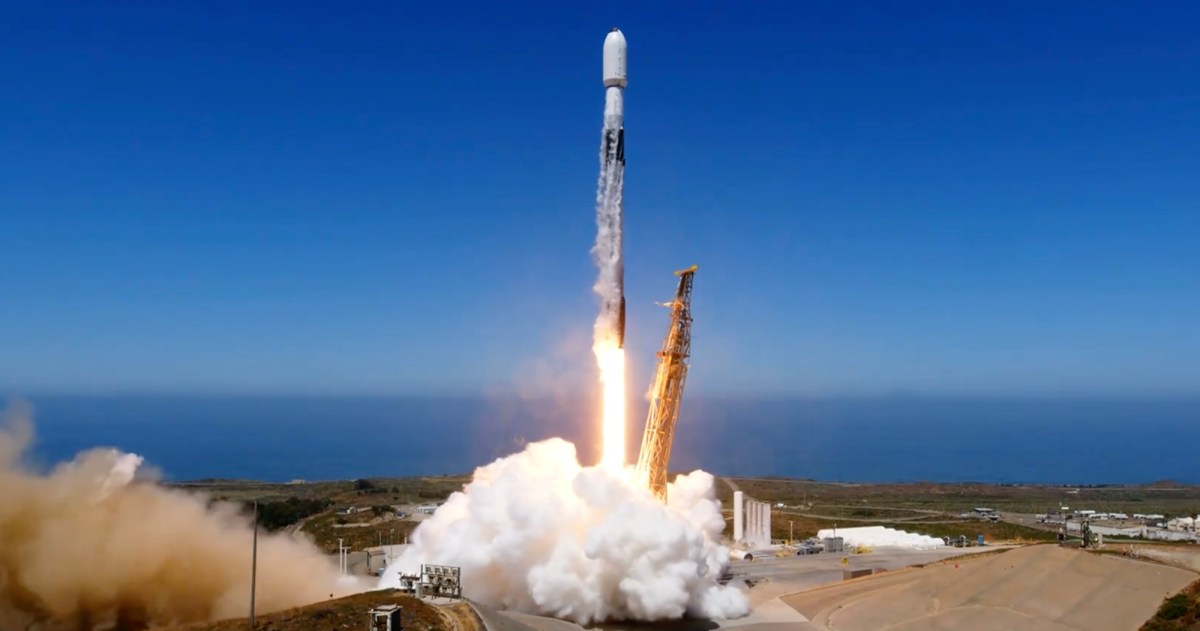WASHINGTON — SpaceX launched the latest in its series of dedicated rideshare missions Aug. 16, putting more than 100 satellites for commercial and government customers into orbit.
A Falcon 9 lifted off from Vandenberg Space Force Base in California at 2:56 p.m. Eastern on the Transporter-11 mission. The rocket’s booster, on its 12th flight, landed back at the launch site seven and a half minutes after liftoff.
Transporter-11 carried 116 payloads for a wide range of government and commercial customers, primarily manifested by aggregators such as Exolaunch, ISISpace, Maverick Space Systems and SEOPS. Those payloads were deployed starting about 54 minutes after liftoff, continuing for more than 90 minutes.
The largest single customer, in terms of number of payloads, was Planet, which had 36 of its Dove imaging cubesats on the launch along with Tanager-1, its first hyperspectral imaging satellite.
Several other companies added to their constellations on the launch, including radar imaging companies Capella Space, Iceye, iQPS and Umbra. Satellogic launched three more imaging satellites while Spire added seven Lemur satellites, four of which have payloads for Internet-of-things (IoT) company Myriota. HawkEye 360 and Unseenlabs also flew satellites to add to their fleets for radio-frequency intelligence services.
The launch included companies flying their first operational satellites. Sateliot, a Spanish startup planning to offer IoT services, flew its first four commercial satellites on Transporter-11. The company had previously launched two prototypes. Tomorrow.io included its first two satellites with microwave sounders for weather forecasting services. Kuva Space, a Finnish startup, flew its first hyperspectral imaging satellite.
The payload stack for the Transporter-11 mission. Credit: SpaceX
Transporter-11 also featured several government customers. United Kingdom Space Command launched Tyche, a150-kilogram imaging satellite built by Surrey Satellite Technology Ltd. The satellite, which will provide imagery with sub-meter resolution, is a pathfinder for a planned intelligence, surveillance and reconnaissance (ISR) constellation for the U.K. military.
NASA launched two technology demonstration cubesats, called PTD-R and PTD-4, on Transporter-11. PTD-R will demonstrate ultraviolet and infrared imaging technologies while PTD-4 will test a deployable solar array technology. NASA arranged for the launch through rideshare aggregator SEOPS using the agency’s Venture-class Acquisition of Dedicated and Rideshare (VADR) contract.
The European Space Agency flew two satellites on Transporter-11. Arctic Weather Satellite is a prototype of a proposed constellation of smallsats that ESA would develop for European meteorological agency Eumetsat for improved collection of weather data in the Arctic that could enable more accurate short-range forecasting. The other, Φsat-2 or Phisat-2, is a technology demonstration cubesat to test the use of artificial intelligence to support Earth observation.
Two other 3U cubesats, a remote sensing mission called TORO and an IoT spacecraft called Nightjar, were developed Taiwanese companies with the support of Taiwan’s space agency, TASA.
The satellites are the first phase of an effort by TASA to build up Taiwan’s space industry, said Chia-Ray Chen of TASA in an Aug. 5 talk at the Small Satellite Conference in Logan, Utah. The two satellites were built over 18 months by Taiwanese companies, he said. TASA is now embarking on a second phase that will include building a small constellation of 8U cubesats with remote sensing, communications and IoT payloads. Those satellites are slated for launch in 2025 and 2026.
Passing the 1,000-payload mark
Transporter-11 was SpaceX’s third dedicated rideshare mission of the year, after Transporter-10 in March and Bandwagon-1, the first mission to a mid-inclination orbit, in April. Such missions continue to be a boon for small satellite developers given the cadence and launches and the prices charged by SpaceX, while a bane for small launch vehicle developers who find it difficult to compete at those prices.
The launch brings the number of satellites deployed through SpaceX’s rideshare program to more than 1,000. In a presentation during a side session at the Small Satellite Conference on Aug. 7, Jarrod McLachlan, director of commercial sales at SpaceX, said the company had launched more than 980 satellites as rideshares on 22 missions. That includes both dedicated rideshare missions and launches that accommodated rideshares along with a primary payload.
The company is planning a regular cadence of three Transporter and two Bandwagon dedicated rideshare missions a year, he said. SpaceX also will offer additional rideshare services on launches with excess capacity, which he noted includes opportunities for missions to geostationary transfer orbit and translunar injection trajectories.
SpaceX used the conference last year to unveil its Bandwagon line of missions, but made no similar announcements at this year’s event. The company is continuing a pricing strategy where it increases the cost per kilogram for rideshare payloads, currently $6,000, by $500 a year, a move he said is intended as an inflation adjustment.
The company is putting a new emphasis on what it calls “cake topper” payloads, or large satellites that can launch on rideshare missions by being positions on the top of the payload adapter, hence the name. “This is really our standard for larger payloads,” he said, covering those weighing between 500 and 2,500 kilograms and responding to customers whose satellites had grown too large to use existing payload accommodations.
SpaceX has flown three rideshare missions with cake topper payloads so far, he said, noting that the design also accommodates a “full stack” of smaller rideshares underneath. Unlike standard rideshare payloads, which can be booked online, cake topper payloads require more customization. “We do not have standard pricing for cake toppers. They tend to be more expensive and a little bit more bespoke as well,” he said.
